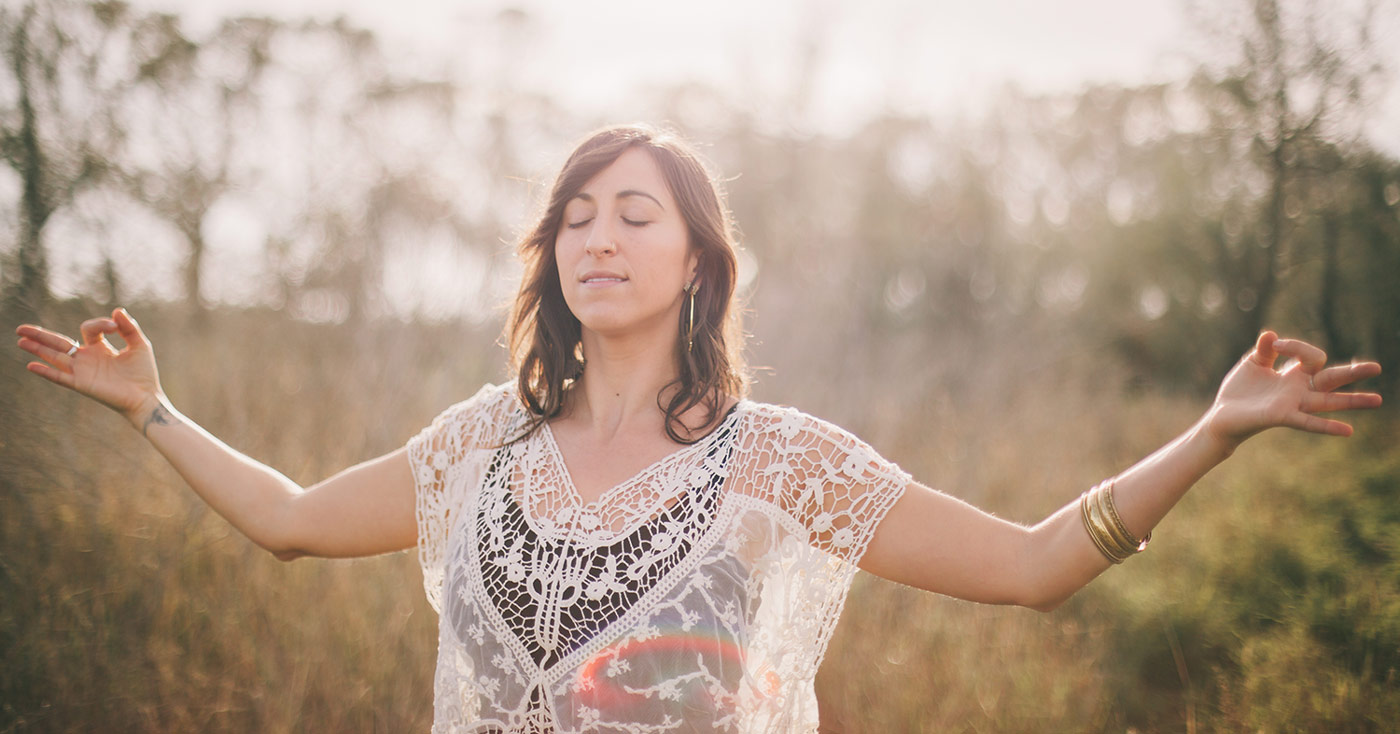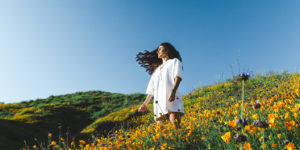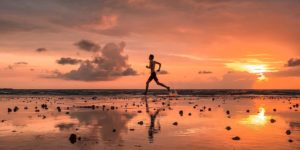Yoga for Depression and Anxiety: 6 Poses to Boost Your Mood and Calm Your Mind
BY OM SWAMI
 yoga poses for depression and anxiety work by rebalancing the body neurologically and energetically to restore harmony, happiness and calm. photo: lerina winter
yoga poses for depression and anxiety work by rebalancing the body neurologically and energetically to restore harmony, happiness and calm. photo: lerina winter
There are numerous yoga postures that can work miracles on your body and mind. Out of hundreds of such postures, I have selected the top three that are particularly good yoga poses for depression and anxiety. The first one, called the Sun Salutation, is not one posture actually but a sequence of twelve postures. As a matter of principle, you should always lie down on your back for a few minutes and breathe gently to conclude your yoga session for mental health every day. Yoga for anxiety and depression can be done once, twice or three times a day, depending on your time availability and your passion.
A session of yoga can last anywhere from twenty minutes to an hour; an average session is thirty minutes. Forty-five minutes is usually ample time to do all the yoga postures for anxiety and depression with feeling and focus. Postures of yoga should not be mistaken as simply stretching of the limbs. Every pore of your existence talks to you if you do them with feeling and that is how yoga for mental health yields the greatest result.1. The Sun Salutation
The Sun Salutation (Surya Namaskara) is the mother of yogic exercises and comprises a sequence of twelve yogic postures with focus on inhalation and exhalation at each step of the salutation. It appears quite simple but is profoundly effective yoga for depression and anxiety. It stretches your entire body and channels the flow of various energies. Here is how to do it:
First Position
Take a deep breath. Stand straight, body relaxed but straight. Bring your hands together and join them near your heart in the posture of Namaste. Exhale.
Second Position
Start inhalation and gently separate your hands and raise them above your head fully stretching your arms. Arch backwards with your palm facing towards the sky. Don’t arch more than you comfortably can.
Third Position
Now exhale slowly and bend forward with your legs straight. Your head will rest between your knees and ideally you should be touching the ground with your hands. If you can’t bend to touch the ground, bend as much as you can.
Fourth Position
Bend your knees as if about to sit on the floor and rest your palms flat on the floor. Stretch your left leg back, with your knee and toe touching the floor. Bring the right leg in front with knee almost touching your chest and foot firmly and fully on the ground. Raise your chin upwards and inhale gently and deeply.
Fifth Position
Bring your left leg back midway and stretch back the right one midway so they are parallel to each other. Raise your hips as if about to do a pushup. Your body now forms a plank. Keep your chin locked to your gullet. Start gentle exhalation and move to the next posture of yoga for anxiety and depression while exhaling.
Stretch your legs back and lower yourself. Your palms, chest, knees and toes touch the ground. Your hips remain a little raised and your belly does not touch the ground at all. Your forehead is parallel to the ground but does not touch it. Hold your breath.
Seventh Position
Start inhaling gently. Straightening your arms, lower your legs and waist so your toes, legs, knees, thighs and groin touch the floor and raise your torso gently arching back your spine. Raise your chin as if looking up and stretching your neck.
Eighth Position
Raise your hips and bring your straightened legs midway. Your body now forms the same triangle. Lower your head and lock your chin in your gullet and exhale gently. Your palms and heels remain flat and firmly planted on the ground.
Ninth Position
Gently inhaling, stretch back your right leg, arching your spine and bring forward your left leg with knee touching your chest. The toe and knee of your right leg touch the ground and the left foot is flat on the ground. Your palms are flat on the ground. Raise your chin up. Now you are in the same posture of yoga to release stress and anxiety as in the fourth position but with the alternate leg stretched.
Tenth Position
Bring your feet together, straighten your legs and bend forward from the waist. Now your posture is exactly the same as in the third position. Once again, try to touch the floor with your palms and if you can’t, lower them as much as you can. Exhale gently, releasing stress and anxiety.
Eleventh Position
Inhale deeply and gently. Straighten your body and arch backwards with your palms facing upwards. This is exactly the same posture now as in the second position.
Twelfth Position
Straighten your body with palms facing each other (as if doing the Namaste posture) and exhale gently. This marks the conclusion of the Sun Salutation, a yoga posture that is effective for depression and anxiety.
Hold each yoga posture for a few seconds. This is one round. In the second round, alternate your legs—stretch the right leg first in the fourth position and the left one in the ninth. There is a variation of this yoga posture for anxiety and depression where the same leg is stretched in the fourth and ninth position and is only alternated in the next round. Lying flat on your back for a few minutes in the corpse pose (shavasana) is highly recommended after completing your anxiety yoga session of the Sun Salutation.
The ancient method also involves chanting the seed syllables of the Sun Mantra while doing the Sun Salutation. Texts expounding the solar science believe that the rays of the first few minutes at sunrise are therapeutic and healing, supportive of yoga for mental health. Ideally, the sun salutation is performed facing the sun at the time of sunrise.
If not feasible, you can do it indoors at the time you do yoga for depression and anxiety or other physical exercises. You can start by doing ten rounds of yoga for anxiety and depression every morning. With practice, your postures will flow into each other in perfect transposition and effortlessness.2. The Shoulder Stand
There are two postures that are not covered in the Sun Salutation.
If you suffer from depression and anxiety, you will benefit much from doing these yoga poses. The first one is called the shoulder stand. It is known as Sarvanga asana in Sanskrit.
Sarvanga means all organs or part. This yoga posture for anxiety and depression infuses vitality into the entire body and mind. Your torso and legs are stretched to the fullest as you raise yourself vertically, with your neck bent and head on the ground, while the weight of your entire body rests on your shoulders. You hold your body with your hands. Here are the steps to do it:
Lie on your back. Relaxed but straight. Keep your legs joined, with your ankles touching each other and toes facing up. Keep your arms straight with your palms touching your thighs.
Gently inhale while you slowly raise your legs, stretching them fully at a ninety-degree angle. Exhale and raise your body while inhaling. Bring your hands to the waist to support your torso as it raises. Raise the body as straight as possible. Keep the legs joined all this while. The entire weight of your body should rest on your shoulders (not on your neck or head). Your chin touching the gullet. Your toes should now be pointing at the ceiling. Breathe gently and normally. Remain in this yoga position for anxiety and depression for thirty seconds. Gradually, you can increase the duration but it should not go beyond three minutes.
To complete the asana, gently bend your legs, folding them at the knees and slowly lower your body, all the while using your hands to support the weight. Once the body is back on the ground, stretch your legs straight and breathe. Pregnant women and anyone who has undergone any form of heart surgery is prohibited from performing this asana. Besides being good for depression and anxiety, this posture is excellent for the spine, nervous system and thyroid glands. At the end of your yoga for depression and anxiety session, always lie down in the corpse pose for three to five minutes.
The shoulder-stand is a variation of the head-stand (shirshaasana). Head-stand is not recommended unless you are disciplined in your practice of pranayama (breath regulation) and completely free of any gastrointestinal, respiratory and neurological disorders.3. Child Pose
It is called Bala Asana. Bala means child. It is a simple and an easy yoga pose for anxiety that has a calming effect on the body and mind. To perform the posture, follow the steps below:
Keep your legs hip-width apart and gently inhale as you kneel on your hands and knees. Your head will rest between your arms and your palms facing down. Straighten your toes so your toenails touch the floor, keeping them relaxed. Exhale and lower your rear towards your heels. This naturally stretches your torso, and as it folds over your thighs, bend your neck so your forehead touches the floor. Gently inhale and bring your arms by your thighs. The palms will face up presently. Breathe slowly and hold this anxiety yoga posture for thirty seconds. To complete this yoga posture for anxiety and depression, bring your arms in front with palms facing down, bring your torso forward and rise up.
You can place a cushion between your buttocks and heels if the stretch is uncomfortable. Feel free to rest your forehead on a cushion if the floor feels hard or uncomfortable.
Regulation Of Breath
There is a term frequently found in most of the yogic scriptures.
It’s called Pranayama. Prana means vital life force in the breath and yama means to elongate, strengthen or progress. Pranayama is the science of breath regulation, which has powerful effects for reducing anxiety, depression and stress. It is primarily of twelve different types. It has three stages called exhalation (rechaka), retention (kumbhaka) and inhalation (puraka). Pranayama is not for everyone: correct breath regulation requires attaining a perfect stillness in the posture and observing a strict dietary and moral conduct. Predominantly though, because through pranayama, you infuse every pore of your body with the vital life-force. If your state of mind is negative and the breath impure, this is what you will push and supply to all the cells.
Each cell is a complete living unit in its own right. It has a respiratory system, an excretory system, a nervous system, an endocrine system. The quality of life-force you supply to each cell has an impact on the life and health of that cell. Pranayama is capable of opening clogged arteries, it makes the muscles supple, gives luster to the skin, reduces stiffness in the joints and infuses life in the veins. Pranayama done wrongly, however, can lead to neurological disorders. That said, if you don’t hold the breath during pranayama, you have nothing to worry about when practicing in tandem with yoga for depression and anxiety. When you simply inhale and exhale in a specific way, it regulates your breath and immediately infuses calm in your mind, helping to reduce anxiety and negative thoughts associated with depression. Of the many types, I will share with you two types of pranayama that are particularly useful in treating depression and anxiety with yoga.
Before you begin pranayama, it is important to sit with your back straight, with your spine, neck and head forming a straight line. If you can sit cross-legged, it is even better because it regulates the vital energies in the body. You can also sit in a chair. At least two hours should have lapsed between your meal and the exercise of pranayama. If you do yoga and then do pranayama, the rewards of that yoga on reducing anxiety and depression are greater and quicker in that case.
These two types of pranayam are best for improving mental health:
4. Alternate Breathing
Alternate breathing is a type of pranayama that is excellent for neurological and respiratory cleansing and detoxification and a great compliment to yoga for depression and anxiety. It forms part of the nervous system-purification (nadi-shodhana) regime. It is called Anuloma-Viloma in yogic texts. Anuloma means natural order and Viloma means reverse order. Retention of breath (kumbhaka) is an important aspect of pranayama fpr depression and anxiety.
Such breathing in its truest sense is recommended for those who have mastered the physical posture and eat only a sattvic diet and are complete teetotalers. Besides, it is a staged progression.
Therefore, in a variation of the standard alternate breathing, my strong recommendation is that you do not hold your breath for anymore than a few seconds (between five and ten at the most).
There is a very important reason to take this seriously. When you practice alternate breathing without gaining stability of posture and without controlling your diet, you run the risk for pushing the toxins through your nervous system to all parts of the body. This can lead to neurological disorders, formation of tumors, cysts and loss of memory. If you practice it without prolonged retention of breath, however, you gain the greatest benefit of pranayama and yoga for depression and anxiety. You purify and cleanse your nervous system and boost the stabilizing energies and forces in and around you. If you have been practicing yoga for a long time (a minimum of two years) and you are on a sattvic diet, you can practice retention for longer time. In any case, do not do it beyond what you are comfortable with. No yogic exercise is supposed to make you look red in the face, during or after. They are supposed to be effortless.
How To Do It Right
Here are the seven steps to the life-transforming alternate breathing pranayama for depression and anxiety:
1. Sit straight, preferably cross-legged or you can sit on a chair.
2. As always, start with complete exhalation with both nostrils.
3. Put the thumb of your right hand on your right nostril to close it.
4. Now breathe deeply, steadily and gently through your left.
5. Hold the breath for a few seconds.
6. Put the middle finger of your right hand on the left nostril and lift your thumb to open the right nostril.
7. Exhale completely, steadily and gently. Ideally, your exhalation should be so soft that you should not even hear yourself breathing out.
Yogic scriptures state the standard one-four-two rule for pranayama. It means if it takes you one second to breath in, for example, you should hold the breath for four seconds (four times the length of inhalation) and exhale over two seconds (double the length of exhalation). However, as I stated earlier, this should only be done if you have been guided by an expert and if you are observing all the rules.
If you have epilepsy or seizures, or if you are on medication for hypertension, or you have palpitation of the heart, or if you have had a heart-attack in the past do not retain the breath at all. Simply just breathe from alternate nostrils. This still has profound effects for reducing anxiety and depression, especially when practiced alongside the yoga poses above. At one stretch you can do twenty repetitions. One complete repetition is inhale from the left, hold, exhale from the right, inhale from the right, hold, and then exhale from the left. This is one repetition. Very few people have the time, but you are free to do it twice or even thrice a day. There is no better purifier of your entire nervous system than pranayama. It is nothing short of a miracle exercise handed down to us by the ancient yogis, making this a good form of breathing and yoga for anxiety and depression and overall mental health.
6. Bumble Bee Breathing
It is called Bhramari pranayama. Bhramara means bumble bee.
As the name says, in this breathing style you make the humming sound of a bumble bee. It has a near instant calming effect on the mind, and is a good pairing to do alongside yoga for depression and anxiety.
Imagine a table with playing cards scattered on it. They look like a mess. Further, imagine organizing those cards to form a neat deck. You can tear a card but you can’t tear apart a deck—it’s stronger, organized and unified. The energies in your body are scattered. There is a mismatch between cellular organization, emotional forces and mental energies; they are not aligned. Bumble bee breathing aligns those energies. The effect is instant and noticeable for improved mental health and reduced anxiety and depression.
How To Do It Right
Bumble bee breathing is an eight-step process as follows:
1. Sit straight, preferably cross-legged or you can sit on a chair.
2. Take a few deep breaths to become aware of your breathing and to normalize it.
3. Spread your hands and bring them to your ears.
4. Now, block your left ear with left thumb and right ear with right thumb. Gently place your index and middle fingers of the right hand on your closed right eye.
5. Do the same on your left eye with your left index and middle fingers. Don’t press your eyes.
6. Rest your ring fingers just below your eyes. Your mouth should be closed and cover your lips with the little fingers.
7. Now, inhale with both nostrils as deeply and comfortably as you can.
8. Once inhalation is done, gently exhale from your both nostrils, producing a humming sound like that of a bee.
Feel free to take breaks after a few rounds as your arms and hands may get tired in that position after a few minutes.
Resume after your break. You can do it up to twenty times in one session and you can do two sessions a day. This pranyama has an extraordinary filtration effect on the body and mind, making it good yoga for reducing stress, anxiety and depression.
If you focus on your diet, do the yoga postures and regulate your breathing, it’ll have a profound impact on your physical well-being and mental health. The stronger and more together you feel physically, the better prepared you are to work on your mental and emotional healing. Eventually, if you can replenish the depleting neurotransmitters in your body by adopting a healthier lifestyle, if you can receive a loving touch, if you can develop that rhythm in your breathing, you will never need to take another antidepressant for reducing depression. You don’t have to take my word for this, or for any other suggestions I make in my book. Try and see it for yourself how pranayama breathing and yoga is good for depression and anxiety.
Your body is a sanctum, a temple, and, as such, should be revered and kept like one. I know, to take control of your health and to change your lifestyle is easier said than done. But, as they say, the journey of a thousand miles begins with a single step. Incorporating yoga for depression and anxiety is a rewarding part of the journey.
This piece on yoga poses for depression and anxiety is excerpted with permission from When All Is Not Well: Depression and Sadness – A Yogic Perspective by Om Sawmi.
About The Author
Om Swami is a mystic who lives in the Himalayan foothills. An advanced yogin, Swami has done thousands of hours of intense meditation in complete seclusion in Himalayan caves and woods. He is also the author of the best-selling If Truth be Told: A Monk’s Memoir. You can connect with him on his blog, omswami.com, which is read by millions all over the world.






















